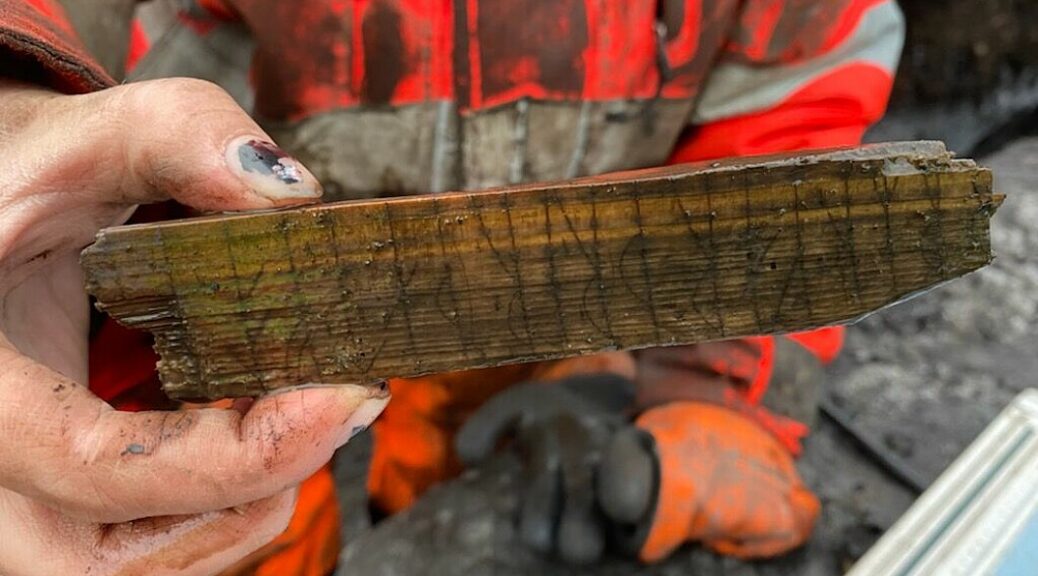Medieval Runes Discovered in Norway

Just before Christmas, archaeologists Solveig Thorkildsen and Ingeborg Hornkjøl, both with the Norwegian Institute for Cultural Heritage Research, NIKU, found two rare objects. A stick inscribed with runes, a so-called rune stick, and a bone, also inscribed with runes, was discovered a few days apart during an ongoing dig at the Medieval Park in Oslo.
Earlier in December, a unique knife handle depicting a king with a hunting falcon on his arm was found in the same place. The findings have been done just about halfway through the excavation.

Runes high on the wish list
“My heart was pounding. Finding runes was at the top of my wish list for this dig,” Solveig Thorkildsen says in an article on niku.no. It was Thorkildsen who found the large bone, probably a rib, which was inscribed with runes on both sides. The rune stick was found by Ingeborg Hornkjøl. It was found in a deep ditch where water was constantly seeping in. The water had washed out a piece of wood, which Hornkjøl thought looked a bit different.
“I thought to myself this cannot be true, this is not true, it’s not true! But it was true!” she says to niku.no.
The rune stick is a piece of wood that is inscribed on three sides, both in Norse and Latin.

Interesting finds
NIKU asked Kristel Zilmer to interpret the runes on the two objects. Zilmer is a professor of runology at the Museum of Cultural History, University of Oslo.
“These are two interesting findings that expand our knowledge about runes, writing and written language in the towns of the Middle Ages,” she says to niku.no.
The context of the runic inscriptions is often unknown, according to Karen Langsholt Holmqvist, who recently defended her PhD on graffiti from the Middle Ages. As the context is often vital for understanding the meaning of the inscriptions, runes from the Middle Ages can be quite difficult to interpret in the 21st century. Zilmer writes in an email to sciencenorway.no that preserved runes often are very short pieces of text. A few typical phrases and expressions are repeated in many such inscriptions.
“The object itself also gives us a few possible keys for interpretation,” she explains.
The inscribed bone is an example of this.
“Working on interpreting runes in today’s day and age isn’t automatically as impossible as it may sound,” according to Zilmer.
“The greatest problems occur where the inscriptions are damaged, where the runic letters are difficult to read or where the inscriptions simply appear as meaningless. But other than that we can get quite a bit of information from the inscriptions themselves, the object they appear on and the context of the find,” she writes.
No sure interpretation yet
Old objects are often tainted by time. The rune stick is damaged, and some of the inscriptions are likely lost.
Nonetheless, Zilmer has managed to interpret several words.
On one of the broadsides, there are two Latin words: manus and Domine or Domini.
Manus means hand, and Dominus means lord or God. The words are found in a known Latin prayer: ‘In Manus Tuas, Domine, commendo spiritum meum’, meaning ‘Into thy hands, O Lord, I commend my spirit’. These are words traditionally attributed to Jesus as he was crucified.
Difficult without a microscope
The short side of the stick may be a continuation of the prayer, Zilmer explains. The first rune is difficult to pin down without a microscope. So far it can be read in different ways.
“It will be easier to establish what the more or less likely interpretations are when I can study this in a microscope,” Zilmer writes.
It is possible that it says “it is true”. If so, then the prayer is similar to one found in the Urnes stave church: ‘Hold thy sacred Lord hand over Brynjolvs spirit. This is true”.
The female name Bryngjerd is also inscribed. Perhaps the rune stick is about Bryngjerd who has given her life to the service of God?
“Many runic inscriptions from the Middle Ages contain simple religious quotes that expressed important messages in a Christian society,” Zilmer explains.
Probably from a large animal
The runic bone is most likely from a large animal such as a horse or a cow, according to NIKU. It will however have to undergo more examinations before this can be determined for certain. Zilmer has also found the inscription of «basmarþærbæin», for which she believes there are two possible interpretations. The first is that this could be the name or the nickname of a person. The other is that the rune describes the bone itself, the object on which the runes are inscribed.
The four last runes, bæin, mean bone in Norse.
Below are3d animations of the two objects. Examine them by zooming and rotating them as you please.
Oslo-people from the Middle Ages
Kristel Zilmer believes that the runic finds in Oslo can teach us more about people who lived in Oslo during the Middle Ages. We know a bit about what people in the Middle Ages thought, felt and found interesting, thanks to the old sagas. The sagas, however, were written in monasteries by people who could write far better than the average person. Runes were on the other hand-carved into items by a much broader section of the population. The newly found runes are from the Middle Ages, according to Zilmer. Characteristics of the runic shapes reveal this.
The question remains whether the context of the finds can give us a more exact dating of the objects. As per the king on the knife handle which was found a few weeks ago, his hairstyle revealed the age.
